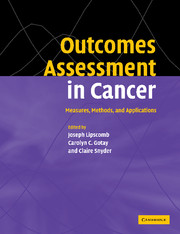Book contents
- Frontmatter
- Contents
- List of contributors
- Acknowledgments
- 1 Introduction to Outcomes Assessment in Cancer
- Health-related quality of life in cancer: general concepts and generic measures
- Assessing health-related quality of life during treatment
- Assessing health-related quality of life across the cancer continuum
- Measuring the experience and needs of cancer patients and caregivers
- Methodological considerations in applications to cancer outcomes research
- 17 Practical considerations in outcomes assessment for clinical trials
- 18 Statistical issues in the application of cancer outcome measures
- 19 The clinical value and meaning of health-related quality-of-life outcomes in oncology
- 20 Cross-cultural use of health-related quality of life assessments in clinical oncology
- Modern psychometric theory in cancer outcomes research
- Assessing the economic impact of cancer
- Research and policy implications
- Invited papers
- Index
- References
18 - Statistical issues in the application of cancer outcome measures
Published online by Cambridge University Press: 18 December 2009
- Frontmatter
- Contents
- List of contributors
- Acknowledgments
- 1 Introduction to Outcomes Assessment in Cancer
- Health-related quality of life in cancer: general concepts and generic measures
- Assessing health-related quality of life during treatment
- Assessing health-related quality of life across the cancer continuum
- Measuring the experience and needs of cancer patients and caregivers
- Methodological considerations in applications to cancer outcomes research
- 17 Practical considerations in outcomes assessment for clinical trials
- 18 Statistical issues in the application of cancer outcome measures
- 19 The clinical value and meaning of health-related quality-of-life outcomes in oncology
- 20 Cross-cultural use of health-related quality of life assessments in clinical oncology
- Modern psychometric theory in cancer outcomes research
- Assessing the economic impact of cancer
- Research and policy implications
- Invited papers
- Index
- References
Summary
Introduction
Are there fundamental differences in the statistical analysis of patient-reported outcomes and other non-biomedical endpoints, on the one hand, and so-called “harder” endpoints such as survival, tumor response, or patient blood pressure on the other?
In this chapter we emphasize that, while the application and interpretation of statistical methods in the outcomes research literature to date has been highly variable, this is not a signal that standard statistical approaches are not up to the task. Rather, they need to be applied with intelligence, completeness, and due consideration to the unique aspects of outcomes research. To that end, this chapter will provide specific examples of how the standard statistical methods have been applied skillfully, while also indicating where the use of novel or modern methods can and should be explored. The idea is not to address all relevant statistical topics and approaches de novo, or to produce yet another primer on statistical methods; there are already texts for this. Our aim, rather, is to ask what is, and what should be, the interplay between each statistical topic and the construction and selection of a cancer outcome measure. If there were little linkage between the statistical topic, on the one hand, and the choice of endpoint measures on the other, then that topic would receive only modest attention. Where the interplay is significant, the spotlight rises accordingly.
- Type
- Chapter
- Information
- Outcomes Assessment in CancerMeasures, Methods and Applications, pp. 362 - 385Publisher: Cambridge University PressPrint publication year: 2004
References
- 2
- Cited by



